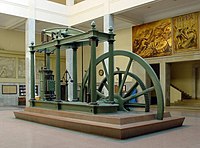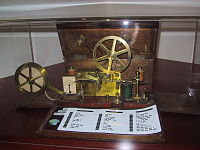Industrijska revolucija

Industrijska revolucija predstavlja prelaz na nove proizvodne procese u periodu od oko 1760. do razdoblja između 1820. i 1840. Ona se sastojala od prelaza sa ručnih proizvodnih metoda na mašinske, nove hemijske proizvodnje i proces za produkciju gvožđa, poboljšane efiktivnosti snaga vode, povećane upotrebe snage pare, i razvoja mašinskih oruđa. Ona je takođe obuhvatala prelaz sa drveta i drugih bio-goriva na ugalj. Industrija tekstila je bila dominantna tokom industrijske revolucije u pogledu zapošljavanja, vrednosti proizvoda i investiranog kapitala; tekstilna industrija je takođe bila prva da primeni moderne metode proizvodnje.[1]
Industrijska revolucija obeležava značajnu istorijsku prektretnicu. Ona je uticala na skoro svaki aspekt dnevnog života na izvestan način. Specifično, prosečni prihod i veličina populacije su počele da manifestuju ranije neviđeni stepen konstantnog rasta. Neki ekonomisti smatraju da je glavni impakt industrijske revolucije da je standard života generalne populacije počeo da konzistentno raste po prvi put u istoriji, mada drugi tvrde nije došlo do znatnog poboljšanja do kasnog 19. i do 20. veka.[2][3][4]
Industrijska revolucija je počela u Velikoj Britaniji, i proširila se na Zapadnu Evropu i Severnu Ameriku u toku nekoliko dekada.[5] Precizni početak i kraj industrijske revolucije je još uvek predmet debate među istoričarima, kao i tempo ekonomskih i društvenih promena.[6][7][8][9] GDP po stanovniku je bio uglavnom stabilan pre industrijske revolucije i pojave moderne kapitalističke ekonomije,[10] dok je industrijska revolucija počela eru ekonomskog rasta u kapitalističkim ekonomijama.[11] Ekonomski istoričari se slažu da je industrijska revolucija najvažniji događaj u istoriji čovečanstva od perioda domestikacije životinaja, biljki[12] i vatre.
Prva industrijska revolucija je prerasla u Drugu industrijsku revoluciju tokom prelaznih godina između 1840. i 1870, kad se nastavilo sa tehnološkim i ekonomskim progresom putem povećane primene parnog transporta (parne železnice i brodova), proizvodnjom mašinskog oruđa na velikim skalama i povećanom upotrebom mašinerije u fabrikama na parni pogon.[13][14]
Parni stroj i njegovo značenje


U 18. stoljeću je najveću manufakturnu proizvodnju imala Engleska. U njoj se povećavala potreba za tkaninama pa su proizvođači tkanina, radi povećavanja i ubrzavanja proizvodnje, primjenjivali izume u poduzećima.
U Engleskoj su proizvođači sve više ulagali novac u stvaranje novih izuma. No, najpoznatiji je bio izum parnog stroja. Njega je 1764. godine usavršio Škot James Watt. Pronalazak parnog stroja izazvao je veliki preokret u proizvodnji, odnosno revoluciju u prerađivačkim djelatnostima ili industriji. Manufakturna proizvodnja zamijenjena tvorničkim radom. Promjene izazvane primjenom parnog stroja nazivaju se prvom industrijskom revolucijom.
Primjena parnog stroja


Novi parni strojevi su vrlo brzo pronašli primjenu u tvornicama, rudnicima i prometu. Strojevi koji su 'koristili vodenu paru kao pogonsko sredstvo morali su biti od čvrstog materijala - željeza. Zbog toga se naglo povećala potražnja za željeznom rudačom i ugljenom.
Amerikanac Robert Fulton je 1807. sagradio prvi parobrod koji je sa strane imao kotače s lopatama, a zvao je Clermont. Već 1819. godine američki je parobrod Savannah preplovio Atlantski ocean za 26 dana.

Godine 1814. Englez George Stephenson' konstruirao je prvu parnu lokomotivu. U početku je išla 20 km/h, a kasnije i brže.
Zvala se Rocket (eng. raketa). Već 1825. u Engleskoj sagrađena je prva željeznička pruga u svijetu. Povezivala je gradove Stockton i Darlington. Prva željeznička pruga na hrvatskom prostoru sagrađena je u Međimurju 1860. godine.
Ostali važniji izumi i djela


U doba prve industrijske revolucije pojavili su se mnogi važni izumi koji se i danas koriste. Amerikanac Benjamin Franklin izumio je 1752. munjovod, djelotvornu zaštitu objekata od udara groma. Englez Sir Humphry Davy načinio je 1815. Davyevu svjetiljku koju su koristili rudari. Time je znatno smanjen broj nesreća u rudnicima. Slijepi francuski učitelj Louis Braille izumio je 1829. pismo za slijepce, poznatije kao Brailleovo pismo: slova brojevi i drugi znakovi na papiru označavaju se posebnim rasporedom ispupčenih točkica.
Amerikanac Samuel Morse izumio je 1837. telegraf i posebnu abecedu nazvanu Morseova abeceda koja se sastojala od dugih i kratkih signala za prenošenje poruka na velike udaljenosti.
Godine 1858. položen je prvi podmorski telegrafski kabel između Amerika i Europe. Francuz Louis Daguerre usavršio je 1839. fotografski aparat, a Amerikanac Charles Goodyear otkrio je vulkanizaciju, tj. način za dobivanje gume iz kaučuka.
Sljedeće godine zalijepljena je na pismo prva poštanska marka na svijetu. Ideju je dao Slovenac Lovrenc Košir, a proveo ju je Englez Rowland Hill. Godine 1854. pojavio se prvi bicikl s pedalama.
Građansko društvo
Tijekom druge polovice 18. i prve polovice 19. stoljeća odvijao se postupni prijelaz iz starog feudalnog u moderno građansko društvo. Na oblikovanje građanskog društva naročito je utjecala primjena parnog stroja u industriji, rudarstvu i prometu. Došlo je do povećanja broja tvornica. U njima je bilo zaposleno sve više radnika. Poslodavci su većinom pripadali građanskom sloju. U većini zapadnih europskih zemalja, osim Nizozemske i Engleske, građanstvo se do 19. stoljeća razvijalo unutar feudalnog sustava, ali nije sudjelovalo u upravljanju državom. Građansko društvo razvilo se i u SAD-u, gdje je sudjelovalo u političkom životu jer u Sjevernoj Americi nije bilo feudalaca.
Promjene na selu
U vrijeme prve industrijske revolucije došlo je do promjena na selu. Seljaci su ranije sve poslove radili ručno, a od početka 19. stoljeća u poljodjelsku se proizvodnju počinju uvoditi strojevi. Jedan od njih bila je žetelica. U poljodjelstvu zapadnih europskih zemalja i SAD-a polako se primjenjuju znanstvane spoznaje - osobito dostignuća kemije (npr. izum mineralnog umjetnoga gnojiva), a obavlja se i odabir boljeg sjemena i stoke. Time je došlo do višestrukog povećanja proizvodnje hrane. Sve te promjene u poljodjelstvu nazivamo agrarnom revolucijom. Uz to je u većini država tijekom 19. stoljeća došlo do ukidanja feudalnih odnosa na selu i jačanja privatnih poduzetnika u poljodjelstvu. Mnogi se seljaci nisu uspjeli održati u novim tržišnim uvjetima pa su ostali najamna radna snaga na velikim posjedima. Neki su se seljaci preseljavali u gradove i zapošljavali kao radnici u tvornicama.
Vidite još
- Arhitektura industrijske revolucije
Reference
- ↑ Landes 1969: str. 40
- ↑ Lucas, Robert E., Jr. (2002). Lectures on Economic Growth. Cambridge: Harvard University Press. str. 109–10. ISBN 978-0-674-01601-9.
- ↑ Feinstein, Charles (September 1998). „Pessimism Perpetuated: Real Wages and the Standard of Living in Britain during and after the Industrial Revolution”. Journal of Economic History 58 (3): 625–58. DOI:10.1017/s0022050700021100. Pristupljeno 6 May 2014.
- ↑ Szreter & Mooney; Mooney (February 1998). „Urbanization, Mortality, and the Standard of Living Debate: New Estimates of the Expectation of Life at Birth in Nineteenth-Century British Cities”. The Economic History Review 51 (1): 104. DOI:10.1111/1468-0289.00084. Pristupljeno 6 May 2014.
- ↑ Landes 1969
- ↑ Eric Hobsbawm, The Age of Revolution: Europe 1789–1848, Weidenfeld & Nicolson Ltd., p. 27 ISBN 0-349-10484-0
- ↑ Joseph E Inikori. Africans and the Industrial Revolution in England, Cambridge University Press. ISBN 0-521-01079-9 Read it[mrtav link]
- ↑ Berg, Maxine; Hudson, Pat (1992). „Rehabilitating the Industrial Revolution”. The Economic History Review (The Economic History Review, Vol. 45, No. 1) 45 (1): 24–50. DOI:10.2307/2598327. JSTOR 2598327.
- ↑ Rehabilitating the Industrial Revolution Arhivirano 2006-11-09 na Wayback Machine-u by Julie Lorenzen, Central Michigan University. Retrieved November 2006.
- ↑ Robert Lucas, Jr. (2003). „The Industrial Revolution”. Federal Reserve Bank of Minneapolis. Arhivirano iz originala na datum 2008-05-16. Pristupljeno 14 November 2007. »it is fairly clear that up to 1800 or maybe 1750, no society had experienced sustained growth in per capita income. (Eighteenth century population growth also averaged one-third of 1 percent, the same as production growth.) That is, up to about two centuries ago, per capita incomes in all societies were stagnated at around $400 to $800 per year.«
- ↑ Lucas, Robert (2003). „The Industrial Revolution Past and Future”. Arhivirano iz originala na datum 2008-05-16. Pristupljeno 2015-04-30. »[consider] annual growth rates of 2.4 percent for the first 60 years of the 20th century, of 1 percent for the entire 19th century, of one-third of 1 percent for the 18th century«
- ↑ McCloskey, Deidre (2004). „Review of The Cambridge Economic History of Modern Britain (edited by Roderick Floud and Paul Johnson), Times Higher Education Supplement, 15 January 2004”.
- ↑ Taylor, George Rogers. The Transportation Revolution, 1815–1860. ISBN 978-0-87332-101-3. No name is given to the transition years. The "Transportation Revolution" began with improved roads in the late 18th century.
- ↑ Hunter 1985
- ↑ Watt steam engine File: located in the lobby of into the Superior Technical School of Industrial Engineers of the UPM (Madrid)
Literatura
- Ashton, Thomas S. (1948). The Industrial Revolution (1760–1830). Oxford University Press. Arhivirano iz originala na datum 2010-02-10. Pristupljeno 2015-04-30.
- Berlanstein, Lenard R., ur. (1992). The Industrial Revolution and work in nineteenth-century Europe. London and New York: Routledge. Arhivirano iz originala na datum 2009-06-06. Pristupljeno 2015-04-30
- Clapham, J. H. (1926). An Economic History of Modern Britain: The Early Railway Age, 1820–1850. Cambridge University Press. Arhivirano iz originala na datum 2009-04-14. Pristupljeno 2015-04-30
- Clapham, J. H. The Economic Development of France and Germany 1815–1914 (1936)
- Clark, Gregory (2007). A Farewell to Alms: A Brief Economic History of the World. Princeton University Press. ISBN 0-691-12135-4
- Daunton, M. J. (1995). Progress and Poverty: An Economic and Social History of Britain, 1700–1850. Oxford University Press. Arhivirano iz originala na datum 2010-02-10. Pristupljeno 2015-04-30
- Dodd, William (1847). The Laboring Classes of England : especially those engaged in agriculture and manufactures; in a series of letters. Boston: John Putnam.
- Dunham, Arthur Louis (1955). The Industrial Revolution in France, 1815–1848. New York: Exposition Press. Arhivirano iz originala na datum 2008-12-24. Pristupljeno 2015-04-30
- Gatrell, Peter (2004). „Farm to factory: a reinterpretation of the Soviet industrial revolution”. The Economic History Review 57 (4): 794. DOI:10.1111/j.1468-0289.2004.00295_21.x.
- Griffin, Emma (2010). Short History of the British Industrial Revolution. Palgrave.
- Haber, Ludwig. The Chemical Industry During the Nineteenth Century: A Study of the Economic Aspect of Applied Chemistry in Europe and North America (1958); The Chemical Industry: 1900–1930: International Growth and Technological Change (1971)
- Jacob, Margaret C. (1997). Scientific Culture and the Making of the Industrial West. Oxford, UK: Oxford University Press
- Kindleberger, Charles Poor (1993). A Financial History of Western Europe. Oxford University Press US. ISBN 0-19-507738-5.
- Kisch, Herbert (1989). From Domestic Manufacture to Industrial Revolution The Case of the Rhineland Textile Districts. Oxford University Press. Arhivirano iz originala na datum 2010-02-10. Pristupljeno 2015-04-30
- Kornblith, Gary. The Industrial Revolution in America (1997)
- Landes, David S. (1969). The Unbound Prometheus: Technological Change and Industrial Development in Western Europe from 1750 to the Present. Cambridge, New York: Press Syndicate of the University of Cambridge. ISBN 0-521-09418-6
- McNeil, Ian, ed. An Encyclopedia of the History of Technology (1996), 1063pp excerpt and text search
- Maddison, Angus (2003). The World Economy: Historical Statistics. Paris: Organisation for Economic Co-operation and Development (OECD)
- Mantoux, Paul (1961) [1928]. „The Industrial Revolution in the Eighteenth Century”. Arhivirano iz originala na datum 2009-04-14. Pristupljeno 2015-04-30
- McLaughlin Green, Constance (1939). Holyoke, Massachusetts: A Case History of the Industrial Revolution in America. New Haven, CT: Yale University Press. Arhivirano iz originala na datum 2010-02-10. Pristupljeno 2015-04-30
- Milward, Alan S. and S. B. Saul. The Development of the Economies of Continental Europe: 1850-1914 (1977)
- Milward, Alan S. and S. B. Saul. The Economic Development of Continental Europe 1780-1870 (1973)
- Mokyr, Joel (1999). „The British Industrial Revolution: An Economic Perspective”. Arhivirano iz originala na datum 2009-05-26. Pristupljeno 2015-04-30
- More, Charles (2000). Understanding the Industrial Revolution. London: Routledge. Arhivirano iz originala na datum 2011-08-14. Pristupljeno 2015-04-30
- Olson, James S. Encyclopedia of the Industrial Revolution in America (2001)
- Pollard, Sidney (1981). Peaceful Conquest: The Industrialization of Europe, 1760–1970. Oxford University Press. Arhivirano iz originala na datum 2010-04-13. Pristupljeno 2015-04-30
- Rider, Christine, ed. Encyclopedia of the Age of the Industrial Revolution, 1700–1920 (2 vol. 2007)
- Smelser, Neil J. (1959). Social Change in the Industrial Revolution: An Application of Theory to the British Cotton Industry. University of Chicago Press. Arhivirano iz originala na datum 2009-04-14. Pristupljeno 2015-04-30
- Staley, David J. ed. Encyclopedia of the History of Invention and Technology (3 vol 2011), 2000pp
- Stearns, Peter N. (1998). The Industrial Revolution in World History. Westview Press. Arhivirano iz originala na datum 2010-04-13. Pristupljeno 2015-04-30
- Smil, Vaclav (1994). Energy in World History. Westview Press. Arhivirano iz originala na datum 2007-07-18. Pristupljeno 2015-04-30
- Snooks, G.D. (2000). Was the Industrial Revolution Necessary?. London: Routledge
- Szostak, Rick (1991). The Role of Transportation in the Industrial Revolution: A Comparison of England and France. Montreal: McGill-Queen's University Press. Arhivirano iz originala na datum 2007-07-18. Pristupljeno 2015-04-30
- Timbs, John (1860). Stories of Inventors and Discoverers in Science and the Useful Arts: A Book for Old and Young. Harper & Brothers.
- Toynbee, Arnold (1884). Lectures on the Industrial Revolution of the Eighteenth Century in England. ISBN 1-4191-2952-X. Arhivirano iz originala na datum 2016-03-03. Pristupljeno 2015-04-30
- Uglow, Jenny (2002). The Lunar Men: The Friends who made the Future 1730–1810. London: Faber and Faber
- Usher, Abbott Payson (1920). An Introduction to the Industrial History of England. University of Michigan Press
- Chambliss, William J. (editor), Problems of Industrial Society, Reading, Massachusetts: Addison-Wesley Publishing Co, December 1973. ISBN 978-0-201-00958-3
- Hawke, Gary. "Reinterpretations of the Industrial Revolution" in Patrick O'Brien and Roland Quinault, eds. The Industrial Revolution and British Society (1993) pp 54–78
- McCloskey, Deirdre (2004). „Review of The Cambridge Economic History of Britain (edited by Roderick Floud and Paul Johnson)”. Times Higher Education Supplement 15 (January).
- Robert C. Allen: The British Industrial Revolution in Global Perspective (New Approaches to Economic and Social History). Cambridge University Press, Cambridge 2009, ISBN 978-0-521-68785-0.
- André Armengaud: Die Industrielle Revolution. In: Carlo M. Cipolla, Knut Borchard (Hrsg.): Europäische Wirtschaftsgeschichte. Band 3, Fischer, Stuttgart / New York, NY 1985, ISBN 3-437-40151-3.
- T. S. Ashton: The Industrial Revolution 1760–1830. Oxford University Press, Oxford 1968.
- T. S. Ashton (Hrsg.): Toynbee's Industrial Revolution. A Reprint of Lectures on the Industrial Revolution in England. With a new Introduction. August M. Kelley, New York 1969.
- Knut Borchardt: Die industrielle Revolution in Deutschland. Piper, München 1972, ISBN 3-492-00340-0.
- Fernand Braudel: Sozialgeschichte des 15.-18. Jahrhunderts, 3. Band, Kapitel 6: Industrielle Revolution und Wachstum. Kindler, München 1986
- Christoph Buchheim: Industrielle Revolutionen. dtv, München 1994, ISBN 3-423-04622-8.
- Flurin Condrau: Die Industrialisierung in Deutschland. Wissenschaftliche Buchgesellschaft, Darmstadt 2005, ISBN 3-534-15008-2.
- N. F. R. Crafts: British Enonomic Growth during the Industrial Revolution. Clarendon, Oxford 1980, ISBN 0-19-873067-5.
- Phyllis Dean: The First Industrial Revolution. 2nd ed. Cambridge University Press, Cambridge 1982, ISBN 0-521-22667-8.
- Arne Eggebrecht, Jens Flemming, Gert Meyer, Achatz v. Müller, Alfred Oppolzer, Akos Paulinyi, Helmuth Schneider: Geschichte der Arbeit. Vom alten Ägypten bis zur Gegenwart. Kiepenheuer & Witsch, Köln 1980, ISBN 3-462-01382-3 (im engeren Sinn zur Industriellen Revolution dort S. 193–302).
- Hans-Werner Hahn: Die industrielle Revolution in Deutschland. 2. Auflage. Oldenbourg, München 2005, ISBN 3-486-57669-0.
- Eric Hobsbawm: Europäische Revolutionen. 1789 bis 1848. Kindler, Zürich 1962; erneut 1978, ISBN 3-463-13715-1.
- Eric Hobsbawm: Industrie und Empire. Britische Wirtschaftsgeschichte seit 1750. 2 Bände. Suhrkamp, Frankfurt am Main 1969.
- David S. Landes: Der entfesselte Prometheus. Technologischer Wandel und industrielle Entwicklung in Westeuropa von 1750 bis zur Gegenwart. (TB-Ausgabe) dtv, München 1983, ISBN 3-423-04418-7.
- Peter Mathias / John A. Davis (Hrsg,): The First Industrial Revolutions. Basil Blackwell, Oxford 1990, ISBN 0-631-16039-6.
- Jürgen Osterhammel: Die Verwandlung der Welt. Eine Geschichte des 19. Jahrhunderts. München 2009, ISBN 978-3-406-58283-7.
- Akoš Paulinyi: Industrielle Revolution. Vom Ursprung der modernen Technik. Reinbek 1989, ISBN 3-499-17735-8.
- Toni Pierenkemper: Umstrittene Revolutionen. Die Industrialisierung im 19. Jahrhundert. Fischer, Frankfurt am Main 1996, ISBN 3-596-60147-9.
- Sidney Pollard: The Genesis of Modern Management. A Study of the Industrial Revolution in Great Britain. London 1965.
- Dieter Ziegler: Die industrielle Revolution. Wissenschaftliche Buchgesellschaft, Darmstadt 2005, ISBN 3-534-15810-5.
Spoljašnje veze
- Industrijska revolucija
- Kako je nastala prva industrijska revolucija?
- O industrijskoj revoluciji Arhivirano 2015-08-26 na Wayback Machine-u
- Industrijska revolucija na Projektu Open Directory
- Internet Modern History Sourcebook: Industrial Revolution Arhivirano 2009-08-31 na Wayback Machine-u
- BBC History Home Page: Industrial Revolution
- National Museum of Science and Industry website: machines and personalities
- Factory Workers in the Industrial Revolution
- Revolutionary Players website Arhivirano 2006-03-08 na Wayback Machine-u
- The Industrial Revolution—Articles, Video, Pictures, and Facts
- Industrial Revolution and the Standard of Living by Clark Nardinelli – the debate over whether standards of living rose or fell.
- The History of the Count House of Ding Dong Mine, Cornwall where Richard Trevithick carried out his first experiments with high pressure steam
- "The Day the World Took Off" Six part video series from the University of Cambridge tracing the question "Why did the Industrial Revolution begin when and where it did." Arhivirano 2013-01-18 na Wayback Machine-u
- Industrielle Revolution (Begriffsdefinition; Lexikon der bpb): Bundeszentrale für politische Bildung (Lexikon)
- Informationen zur politischen Bildung (Heft 164): Das 19. Jahrhundert 2
- Friedrich Engels: Zur Lage der arbeitenden Klasse in England (mit Links zu den einzelnen Kapiteln)
